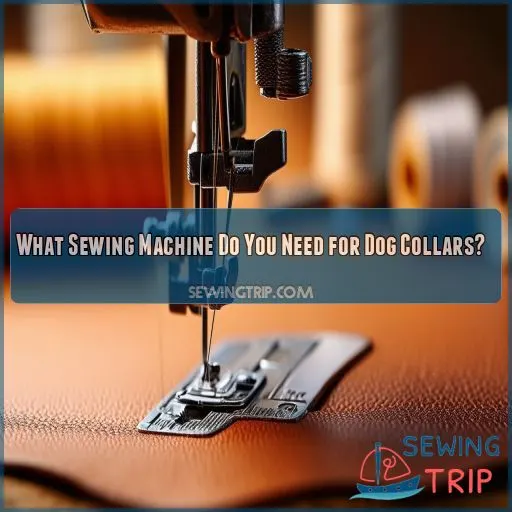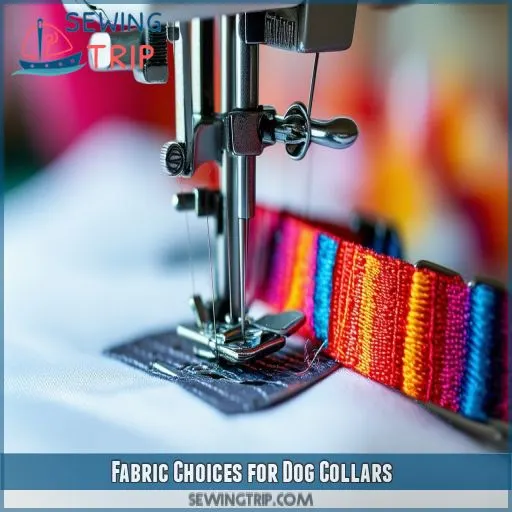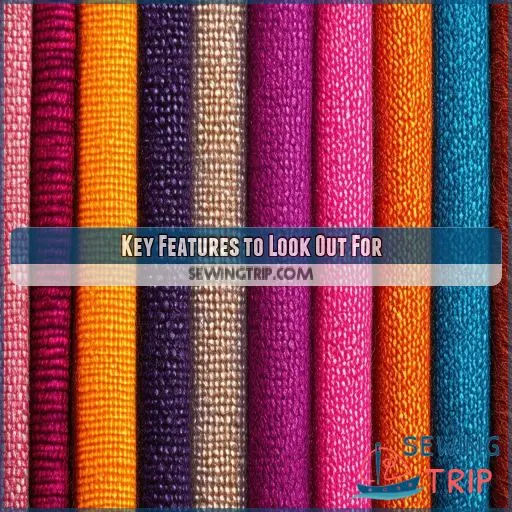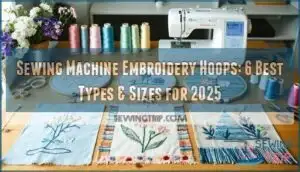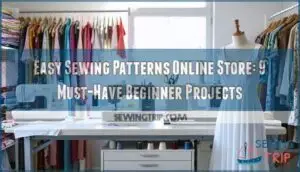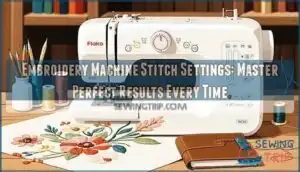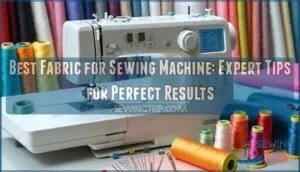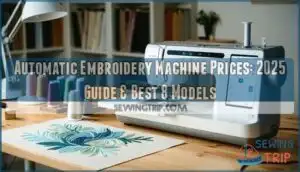This site is supported by our readers. We may earn a commission, at no cost to you, if you purchase through links.
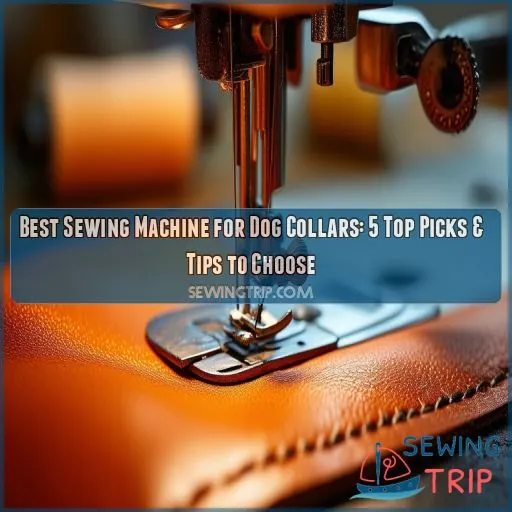 Looking to craft some stylish collars for your furry friends?
Looking to craft some stylish collars for your furry friends?
Sewing your own dog collars is a fun project that lets you customize their accessories.
To get started, you’ll need the right sewing machine, and that’s where we come in.
We’ve rounded up the five best sewing machines for dog collars, offering a mix of features to suit different needs.
From beginner-friendly options to heavy-duty workhorses, we’ll help you find the perfect machine to bring your creations to life.
Table Of Contents
Key Takeaways
You don’t need to be an expert to sew dog collars. Whether you’re a beginner or a pro, there’s a sewing machine that’s perfect for crafting collars for your furry friends.
The best sewing machine for dog collars will depend on your skill level and the materials you’re using. Beginner-friendly machines offer simplicity and ease of use, while heavy-duty machines are built for tougher projects and more durable fabrics.
When choosing a sewing machine for dog collars, look for features like automatic needle threading, a variety of presser feet, adjustable speed control, and free arm access for maneuvering around tight spaces.
Popular fabric choices for dog collars include leather, heavy-duty canvas, nylon, cotton, linen, and fleece, each offering unique benefits in terms of durability, comfort, and style.
What Sewing Machine Do You Need for Dog Collars?
So, what kind of sewing machine do you need for crafting dog collars? Well, it depends on your skill level and the materials you’re working with.
Let’s break it down.
Beginner-Friendly Machines
If you’re new to sewing, beginner-friendly machines are a great option for crafting dog collars.
These machines are simple to use, with basic features and straightforward controls.
They’re durable, affordable, lightweight, and perfect for working with light fabrics like cotton and nylon.
Entry-level machines are ideal for starting out, focusing on essential functions for basic dog collar construction.
Popular brands for beginners include Brother, known for their user-friendly features, and Singer, offering a range of models for various skill levels.
Mid-Range Machines
If you’re looking for more features and durability, mid-range sewing machines are a great option for crafting DIY dog collars.
These machines offer adjustable stitch lengths, widths, and tensions, giving you greater control over your sewing projects.
Built to last, they can handle heavier use and more demanding projects.
You’ll also find enhanced functionality, such as automatic needle threading and bobbin winding, which streamline your sewing experience.
With a moderate price point, mid-range machines offer a balance between affordability and advanced capabilities, making them a versatile choice for dog collar sewing enthusiasts.
Heavy-Duty Machines
Heavy-duty machines are great for sewing dog collars. Here’s why they’re a top pick:
- Powerful Motor: Sew through thick fabrics and multiple layers with ease.
- Robust Construction: Built to last and handle heavy-duty tasks without breaking a sweat.
- Adjustable Settings: Enjoy a wide range of stitches and settings to customize your collars.
Machines With Special Features
Sewing machines with special features offer unique capabilities that can elevate your dog collar crafting.
Consider machines with built-in embroidery to personalize your collars with intricate designs and embellishments.
An automatic buttonholer adds functionality, while free-arm sewing simplifies stitching around curves and small areas.
For seamless bobbin replacement, look for a drop-in bobbin feature.
Additionally, an adjustable needle position gives you greater control over stitch placement, ensuring precise results.
These features enhance your creative possibilities and make crafting dog collars a breeze.
Top 5 Sewing Machines for Dog Collars
Now that you know what to look for, let’s check out the top 5 sewing machines for dog collars. We’ll explore their features, pros, and cons to help you make an informed decision.
1. Singer Sewing Quilting Machine Accessory Kit
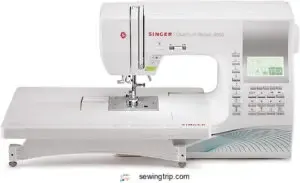
If you’re looking for a good kit to get you started on your dog collar sewing journey, the Singer Sewing Quilting Machine Accessory Kit is a solid choice.
This kit provides a range of essential accessories to complement your sewing machine, ensuring you have everything you need in one convenient package.
While it doesn’t include the sewing machine itself, this kit is designed to work seamlessly with Singer machines and enhance your overall sewing experience.
You’ll find a variety of presser feet, needles, bobbins, and other tools that will come in handy as you craft those collars.
Best For: The Singer Quantum Stylist 9960 is best for sewers of all levels who want a machine with a wide range of features and a solid build.
- Easy to use, even for beginners.
- Includes a thread cutter and needle threader.
- Extensive accessory set.
- Stitch settings aren’t color-coded.
- Adjustment screw for stitch patterns is located on the bottom of the machine.
- Some users found the included straight stitch foot too narrow for quilting.
2. Brother CS6000i Sewing Quilting Machine
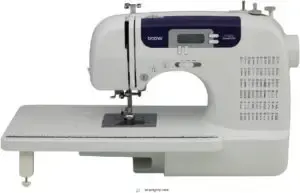
If you’re looking for a versatile machine that’s perfect for quilting and sewing, the Brother CS6000i Sewing Quilting Machine is an excellent choice. It offers 60 built-in stitches, including decorative options and seven styles of auto-size buttonholes, giving you plenty of creative freedom. The machine is easy to use, with a simple-to-view backlit LCD display, an automatic needle threader, and adjustable sewing speed control.
One of the standout features is its durability. It comes with a hard machine case, making it perfect for travel and ensuring your machine stays in good condition. It also provides great value for money, as it includes a wide range of accessories, such as nine presser feet, a needle set, bobbins, and a screwdriver, all at an affordable price.
However, there are a few things to keep in mind. The maximum speed of 750 stitches per minute might be slower than some other machines, and it’s not recommended for heavy fabrics. Additionally, some users have found the buttonhole markings difficult to read, and the work light could be stronger.
Best For: The Brother CS6000i is best for beginners and experienced sewists looking for a versatile and affordable machine for quilting and sewing.
- Easy to use with automatic needle threading and adjustable speed control.
- Durable and portable with a hard machine case.
- Offers great value for money with a wide range of accessories.
- Maximum speed is slower than some other machines.
- Buttonhole markings can be difficult to read for some users.
- Work light may not be strong enough.
3. Brother XR9550PRW Sewing Machine
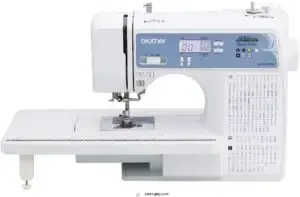
The Brother XR9550PRW sewing machine is an excellent choice for dog collar projects.
It offers a wide range of features that make it a versatile and user-friendly option.
With a variety of built-in stitches, you can create different looks for your dog collars.
The automatic needle threader, drop-in top bobbin, and LCD screen enhance its ease of use, even for beginners.
It also comes with a range of accessories, including a hard cover, wide table, and multiple sewing feet to accommodate various sewing needs.
Its lightweight design makes it portable, yet it maintains a sturdy and solid feel.
This machine is highly regarded for its good value, striking a balance between features and price.
Best For: This machine is best for beginners and those who need a versatile machine for various projects, including dog collars.
- Automatic needle threader makes threading a breeze.
- Lightweight design allows for easy portability.
- Offers a good balance of features and price for its value.
- The included accessories may be limited for those who do more advanced sewing.
- The plastic construction may not be as robust as some users would prefer.
- Some users have experienced thread snags and breaks due to the horizontal thread placement.
4. Brother SE1900 Sewing Embroidery Machine
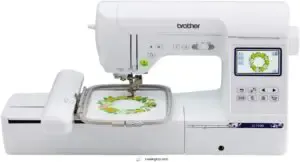
The Brother SE1900 Sewing Embroidery Machine is a versatile choice for dog collar projects.
It offers a wide range of built-in designs and stitches, making it easy to personalize your creations.
With 138 designs, 11 embroidery fonts, and 240 built-in sewing stitches, you’ll have plenty of options to choose from.
The advanced needle threader simplifies the threading process, and the jam-resistant drop-in top bobbin helps to keep sewing smooth.
The large, full-color touchscreen display makes it easy to navigate through the various features.
Keep in mind that this machine is designed for use in the US at 120 volts, so voltage converters may be necessary for use in other countries.
Best For: The Brother SE1900 is best for crafters and sewists looking for a machine that can handle both sewing and embroidery projects, especially those who want to personalize dog collars.
- Large touchscreen display for easy navigation.
- Built-in designs and stitches for a wide range of customization options.
- Advanced needle threader and jam-resistant bobbin for smooth operation.
- Machine is loud when embroidering.
- May require a voltage converter for use outside the US.
- Requires a separate spindle holder for larger embroidery spindles.
5. Singer Quantum Stylist 9985 Sewing Machine
The Singer Quantum Stylist 9985 Sewing Machine is a robust and versatile option for crafting dog collars.
With a maximum sewing speed of 850 stitches per minute, this machine helps you sew seams efficiently.
It offers a wide selection of 960 built-in stitches, including alphanumeric fonts and various buttonhole options, letting you create personalized and decorative designs.
The automatic needle threader simplifies the threading process, saving you time and effort.
Additionally, the machine comes with a range of accessories, such as different presser feet, to enhance your sewing capabilities.
While some users have reported issues with the automatic needle threader on previous Singer models, the Quantum Stylist 9985 stands out for its ease of use, high-speed performance, and expansive stitch options, making it a reliable choice for your dog collar projects.
Best For: Sewing enthusiasts who want a versatile machine for various projects, including crafting dog collars.
- Features a wide selection of 960 built-in stitches, including alphanumeric fonts and buttonhole options.
- Includes an automatic needle threader for quick and easy threading.
- Comes with a range of accessories to expand sewing capabilities.
- Some users have reported issues with the automatic needle threader on previous Singer models.
- The machine is fairly quiet, but some users wish the light was brighter or there was more than one light.
- The pedal can be prone to slipping on smooth surfaces.
Fabric Choices for Dog Collars
When choosing a fabric for your dog’s collar, you’ve got options. Leather, heavy-duty canvas, nylon, cotton, linen, and fleece are all popular choices, each offering unique benefits. You can also opt for multi-purpose materials that offer flexibility in design and use.
Leather
Leather is a top choice for dog collars because it’s tough, strong, and high quality. It’s a classic fabric that gives dog accessories a sophisticated look. Here are some things to keep in mind when sewing with leather:
- Stitching: Use a heavy-duty needle and a longer stitch length to make sure your stitching is strong and secure.
- Supplies: Invest in leather-specific sewing supplies, such as a leather needle, heavy-duty thread, and a rotary cutter for smooth, precise cuts.
- Practice: Leather is less forgiving than other fabrics, so it’s important to practice your stitching technique on scrap pieces first.
- Design: When creating dog collars, think about adding decorative elements like studs or rivets for a stylish touch.
Heavy-Duty Canvas
For making dog collars, heavy-duty canvas is a top choice because of its durability and strength.
This fabric can withstand the wear and tear of your furry friend’s adventures, ensuring their collar stays intact.
When sewing with heavy-duty canvas, you’ll want a machine that can handle the thickness of the fabric and provide strong stitching.
Look for a machine with a powerful motor and reinforced parts to easily sew through multiple layers of canvas.
Nylon
Nylon is a great choice for dog collars because of its durability and strength.
It’s resistant to fraying, making it ideal for active dogs who like to explore.
If you’re new to sewing for dogs, nylon is a good fabric to start with as it’s easy to work with and won’t stretch or shift as you sew.
You can find nylon webbing in a variety of colors and widths to create stylish and functional collars.
Cotton, Linen, and Fleece
Cotton, linen, and fleece are soft, comfortable options for dog collars. They’re perfect for everyday wear and can be easily customized with fun patterns and colors. If you’re an apprentice seamstress, these fabrics are a great choice to work with as they’re simple to sew and handle.
Multi-Purpose Materials
Multi-purpose sewing machines offer the ultimate versatility for dog collar projects. With these machines, you can seamlessly work with a variety of materials, including leather, canvas, and nylon. Here are three reasons why multi-purpose machines are a great choice:
- Durability: These machines are built to handle a range of fabrics, ensuring long-lasting performance.
- Versatility: The ability to work with multiple materials gives you creative freedom and flexibility.
- Reliability: With a multi-purpose machine, you can trust that it will handle whatever fabric you throw at it, making it a reliable choice for pet supplies, sewing classes, or even a high school freshman project for your Great Dane!
Key Features to Look Out For
When choosing a sewing machine for dog collars, there are several key features you should look out for to get the best results. These include the number and types of stitches available, automatic needle threading, a variety of presser feet, adjustable speed control, and free arm access for sewing sleeves and cuffs.
Stitch Options
Choosing the right stitch can make a world of difference in your final project, whether you’re a textile engineering enthusiast or a fashion student aiming to create a high-quality fashion masterpiece.
| Stitch Type | Description |
|---|---|
| Straight Stitch | Basic stitch for simple seams |
| Zigzag Stitch | Provides stretch and flexibility |
| Overlock Stitch | Professional finish for seams |
| Decorative Stitches | Add unique designs and embellishments |
The variety of stitches a machine offers will determine the projects you can undertake. Some machines provide adjustable stitch lengths and widths, allowing you to customize your stitches for a precise fit.
Automatic Needle Threading
Automatic needle threading is a handy feature to look out for when choosing a sewing machine. Here’s why it’s a key feature and how it can benefit you:
- Ease of Threading: Automatic needle threading eliminates the hassle of manually threading the needle, making the process quicker and more convenient.
- Time Saver: This feature speeds up your sewing projects by reducing the time spent on threading, allowing you to focus on the actual stitching.
- Frustration Reducer: No more squinting or struggling to get the thread through the eye of the needle. Automatic needle threading takes care of this tedious task for you, reducing eye strain and frustration.
- Beginner-Friendly: If you’re new to sewing, automatic needle threading can be a lifesaver. It simplifies the sewing process and makes it more accessible, helping you build your skills and confidence.
Presser Foot Variety
When you’re sewing dog collars, the presser foot you choose is important.
You want a variety of options to work with different fabrics and techniques.
From the standard presser foot for general sewing to specialty feet like the walking foot for quilting or the roller foot for leather, having a range of choices will make your projects easier and more professional-looking.
Speed Control
Speed control is an essential feature when sewing dog collars.
It gives you precision and control over your stitching speed, ensuring smoother and more consistent results.
This is especially important when working with various fabrics and thicknesses, as you can adjust the speed to suit the material.
For example, you might want a slower speed for intricate stitching or when working with delicate fabrics, while faster speeds can be more efficient for longer, straight stitches.
Look for a machine with adjustable speed settings to give you greater control over your sewing projects.
Free Arm Access
For those fiddly sleeves, cuffs, and other small, curved projects, free arm access is a game-changer. This feature lets you easily maneuver around tight spaces, making it a breeze to sew dog collars, sleeves, and pant legs. No more struggling to navigate those narrow areas!
Imagine the freedom and precision you’ll have with a free arm. It’s like having an extra hand to guide your fabric, ensuring smooth, even stitches on cylindrical items.
Frequently Asked Questions (FAQs)
What kind of sewing machine do I need to make dog collars?
You’ll need a sturdy machine to sew dog collars. For nylon webbing, a Juki industrial machine is a good choice. For cotton, a Brother CS6000i with a heavy-duty needle works well.
What fabric do you use for dog collars?
For sensitive dogs, hemp, cotton, and velvet are ideal fabrics for dog collars. Hemp is durable, repels grime and odour, and helps with skin allergies. Velvet is soft and comfortable, reducing chafing. Cotton is best without dyes or chemical washes.
Can you sew a dog collar?
Yes, you can sew a dog collar. It’s a fun project and you can create a collar that’s both stylish and comfortable for your furry friend.
How to manufacture a dog collar?
First, choose your materials. Next, measure your dog’s neck for the right fit. Cut the collar material to the right length, adding an extra inch for the buckle and D-ring. Attach the hardware and wrap the fabric strip around the collar.
Can I use a sewing machine for leather?
You’re in luck! You can use a sewing machine for leather, but you’ll need to make some adjustments. First, swap out the regular needle for a leather one. You’ll also want to avoid using pins, as they’ll dent your leather, and opt for double-sided tape instead.
Are heavy-duty machines only for experts?
Heavy-duty machines aren’t just for experts. They’re also great for beginners and can be used to tackle tough projects.
How much do I need to spend?
Sewing machines vary in price. Mechanical machines start from $60, while computerized models begin at $ A good machine costs at least $150, but some machines cost over $10, $200-$350 is a good budget for a beginner.
Whats the best brand for beginners?
Brother is a popular brand for beginners. The Brother ST371HD "Strong and Tough" is user-friendly, with a simplified threading system and an automatic needle threader. Singer is another well-known, reliable brand for beginners.
Do I need a special machine for nylon?
You can sew nylon with a regular sewing machine, but you may need to make some adjustments. Use a heavy-duty or denim needle, strong thread, and a walking foot attachment. You may also need to adjust the stitch length to prevent the fabric from bunching.
Conclusion
So, which is the best sewing machine to sew dog collars?
It depends on your needs and preferences.
Whether you’re a beginner or a pro, there’s a machine that’s perfect for crafting collars for your furry friends.
We’ve explored a range of options, from beginner-friendly to heavy-duty machines, and highlighted some top picks to get you started.
With the right sewing machine and the right fabric, you’ll be well on your way to creating stylish and durable dog collars.

